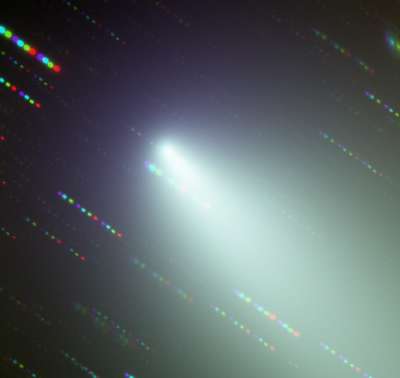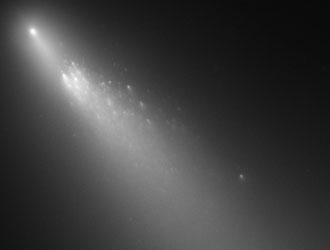Avi Blizovsky

On the night between April 23 and 24, the very large telescope of the European Space Agency at the European Southern Observatory (ESO) in Chile observed the B fragment of the comet Schwarzman-Wachmann 3 (or SW3 for short) that split from the comet a few days earlier. To their surprise, the ESO astronomers discovered that this rift is splitting again. Five comet species were seen in the image. It seems that the comet was damaged and ended up disintegrating into small parts, the only question is how long the process will take.

Now NASA has announced that the Hubble Space Telescope has also photographed the disintegrating comet in much finer detail than can be seen with a ground-based telescope. Hubble's photograph adds that the comet broke up into almost 40 pieces, much more than can be seen with telescopes from the ground.
Comet SW3 is a celestial body with a troubled past. The comet orbits the sun in an orbit that is approximately 5.4 years long. The elongated orbit brings it from the interior of the Earth's orbit to the vicinity of the giant Jupiter.
In 1995, it came close to Earth and suddenly shone with an intensity of a thousand times its normal intensity. Observations made in 1996 using the 3.6-meter telescope, also of ESO, showed that the eruption was due to the fact that the comet split into three distinct parts. At the end of that year, two more fragments were discovered. On the previous visit, in 2001, only three of the five fragments were still visible. Fragment C, the largest, as well as fragments B and E. No new split was known at that approach.
This time, when the comet approached its closest point to the Sun (and the Earth) again, seven fragments were observed at the beginning of March. The large one - C - was seen at magnitude 12, which is 250 times fainter than the naked eye can see, while the B fragment was ten times fainter. On March 6, six new fragments were discovered.
At the beginning of April, fragment B suddenly erupted, its light increased 10 times and on April 7, six new fragments were discovered, which indicated a high degree of disintegration of the comet. On April 12, B was as bright as the main fraction C, magnitude 9 (still 16 times fainter than the eye can see without the aid of a telescope). Fragment B appears to have broken up again, bringing the number of known fragments to 40. Some of them are probably very small - objects the size of a cliff on Earth, with an irregular shape and a short life.
The new observations reveal that the new small fragments have split again. The photo clearly reveals fragment B and next to it a small fragment that split into two. A detailed analysis of the image shows five more tiny fragments arranged in an almost straight line. The comet appears to have disintegrated into a series of mini comets.
!
Will the process continue? Will more and more parts be created and will the comet finally disintegrate? How bright will the fragments be when the comet approaches Earth on May 11 to 14, and how many new fragments will appear before the comet reaches its closest point to the Sun - around June 7?
Fragment C is expected to approach Earth on May 11th, it will come as close as 12 million kilometers from us while Fragment B will approach as close as 10 million km on May 14th. This is the closest approach of a comet to Earth in the last twenty years. Even the distance of the brightest asteroid visible to the naked eye, Ikutaka, has been approached as close as 15 million kilometers. It is still a distance that is 26 times the distance of the moon from us and therefore no danger to the earth is expected.
If nothing unusual happens at closest approach, experienced observers without telescopes will be able to spot fraction B. It should be an easy target to observe in the Milky Way. If there is any luck, the B fragment may show another eruption and become the focal point for a spectacular observation of the night sky. On the other hand, he can also disappear into oblivion. But then, the C fraction may also be visible to the naked eye.
ESO's telescopes will continue to observe the comet until the end of May, as long as it can be viewed from Chile and is quite bright.
For the news in Universe Today
They knew asteroids and comets
https://www.hayadan.org.il/BuildaGate4/general2/data_card.php?Cat=~~~463162493~~~18&SiteName=hayadan
